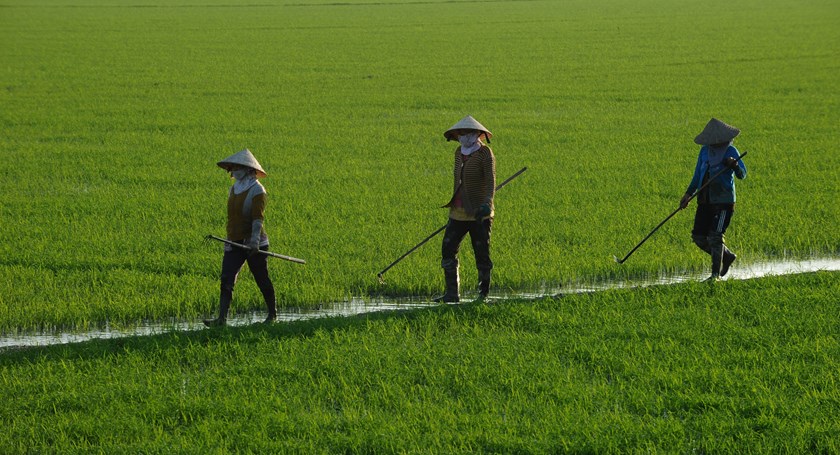Southeast Asia is home to poor small-scale farmers like her who, despite hardship, prop up the region's agriculture sector.
Agriculture contributes significantly to the gross domestic product and provides employment to the labor force of several countries in the region.
However, Oxfam's new report, Harmless Harvest, argues that climate change is undermining the viability of agriculture in the region and putting many small-scale farmers' and fisherfolks’ livelihoods at risk.
The report found that increasing temperatures are linked to declining rice yields. According to the International Rice Research Institute, rice yields drop as much as 10 percent for every 1 percent rise in temperature – a worrisome statistic for a region which considers rice as a staple cereal.
Citing a study by N.K. Redfern et al presented at a FAO/OECD workshop in Italy, in 2012, the report found that in Cambodia, Laos, Thailand, Myanmar and Vietnam, rainfall has been below average since 2009, resulting in droughts, which are correlated to lower yields and increased pest and plant disease infestation. Where irrigation facilities are woefully few, this trend is a cause for concern.
Rising sea levels also cause saltwater to seep into water sources and agricultural lands in Indonesia and Vietnam, affecting rice and food production, a study of the Asian Development Bank found.
Extreme weather events, which show up more and more on the doorstep of Southeast Asia, are the bane of agriculture.
The Fifth Assessment Report of the Intergovernmental Panel on Climate Change (IPCC) found that in Cambodia, intense floods and droughts accounted for 90 percent of rice production losses from 1996 to 2001. In 2013, super typhoon Haiyan decimated more than 30 million coconut trees, on which hundreds of thousands of poor families in central Philippines depend for their livelihood.
On the flip side, agriculture's contribution to greenhouse gas (GHG) emissions is also on the rise. According to the IPCC, agriculture accounts for 14 percent of total GHGs, the same level of emissions from the industry and transport sectors. Large-scale industrial agriculture is responsible for these agricultural emissions.
Sustainable agriculture
Against this background, what can the Association of Southeast Asian Nations (ASEAN) do to make small-scale farmers and agriculture become resilient to climate change?
Bet on sustainable agriculture and agro-ecology.
Sustainable agriculture practices include crop diversification, composting, responsible water management, and rehabilitation of degraded soils.
Agro-ecology's virtues include recycling biomass to enhance the soil's nutrients, managing water more efficiently, intercropping, and using heirloom seeds. Agro-ecology upholds the symbiotic interaction between plants, insects, animals, soil, and the surroundings to maintain a flourishing ecosystem.
Both sustainable agriculture and agro-ecology put a premium on small-scale farmers' welfare and livelihood.
Sustainable agriculture and agro-ecology practices are, in effect, also ways to adapt to climate change and mitigate its impact. Those practices will help farmers grow food in a changing climate (climate adaptation) without further emitting GHGs (climate mitigation).
For agriculture to thrive in a looming climate crisis, ASEAN must shift to sustainable agriculture and agro-ecology, which can be expressed concretely in a number of ways.
First, ASEAN must duplicate sustainable agriculture and agro-ecology practices across the region. One such program is SRI or Systems of Rice Intensification, which optimizes harvests without depleting soil nutrients, and uses rice varieties that can withstand floods or droughts. SRI is already gaining ground in Cambodia, Vietnam, and the Philippines.
Women, who are also food producers, must be included in these programs. Women are often mistakenly not counted as economic actors, and are therefore left out of development projects.
Second, ASEAN should look at forming a centralized knowledge hub for adaptation and mitigation which will allow member states to share and access information such as climate impacts on agriculture and good practices of agricultural adaptation.
Third, ASEAN should study the creation of an ASEAN fund for adaptation and mitigation. Damages to agriculture wrought by disasters cost billions of dollars. Early warning systems and localized weather forecasting and climate data collection would save many a harvest from being submerged.
Finally, national governments in ASEAN must incentivize small-scale farmers to continue or adopt sustainable and agro-ecological farming practices.
The stakes are too high for small-scale farmers in the age of climate change.
ASEAN must bet on poor farmers and sustainable agriculture and agro-ecology for the region to deal with certain risk.
Source: Thanh Nien News | 26 May 2015














